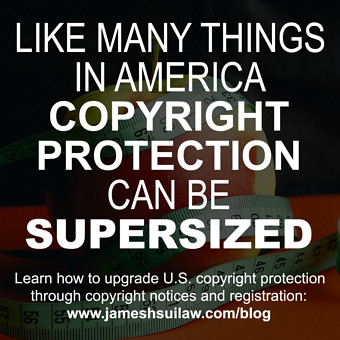
The last post, “How do I get Copyright Protection?,” gave an overview of what is copyright, what can be copyrighted, and how you can obtain copyright protection in the United States and internationally. Most significantly, we discussed how you get copyright protection automatically for copyrightable stuff, and that copyright registration and copyright notices (e.g., using the © symbol) are not necessary to obtain copyright protection, but do confer benefits.
Today, as promised, we will discuss copyright notices and registration further. Specifically, this post will explain
- Why copyright notices and registrations are not necessary,
- What the benefits of using a copyright notice are,
- How to use a copyright notice,
- What the benefits copyright registration are, and
- How to perform copyright registration.
Why copyright notices and registrations are not necessary?
Today, copyright protection can be obtained automatically by creating or publishing your work. However, this was not the case before 1989. What happened in 1989 that made it a special year for U.S. copyright law? In 1989, the United States, after a little more than 102 years since the first signing of the oldest and most significant copyright treaty in the world, Berne Convention for the Protection of Literary and Artistic Work, finally became a member of the Berne Union (i.e. became a party to the treaty).
Copyright registration and the use of a copyright notice are “formalities” of copyright protection. Article 5 of the Berne Convention contains a prohibition on the use of formalities as a prerequisite for copyright protection obtained under the aegis of the Berne Convention. To comply with this requirement, the U.S. retooled its copyright registration and notice requirements by granting basic copyright protection to copyright holders automatically, and then allowing them to “supersize” it.
What are the benefits of using a copyright notice?
The first upgrade you can make to copyright protection is using a copyright notice. This is a “free” upgrade.
The main benefit of using a copyright notice is it tells the world that your work is protected by copyright. An added benefit, which comes from telling the world that your work is protected by copyright, is that it keeps those who would use or reproduce your work without your permission from claiming that they are “innocent infringers” (i.e. the “I had no idea the work was copyrighted” excuse). If a copyright owner sues and wins, an “innocent” infringer will pay a copyright owner less money than a guilty one.
How is a copyright notice used?
Three things are generally needed for a copyright notice to be effective:
- An indication of copyright,
- The first year the copyrighted work was published, and
- The name of the copyright holder
Indications of copyright include the “©” symbol, the word “Copyright” or the abbreviation “Copr.”. However, a special rule exists for anything published in the form of a sound recording or “phonorecord”: the form of indication that should be used is a “P” inside a circle (℗).
A typical copyright notice for a book would look something like this: “© 2015 Myst Inc.”
What are the benefits of copyright registration?
The second upgrade you can make to copyright protection is to copyright registration. Unlike the notice, it is not a “free” upgrade because there are filing fees involved and one or more samples must be deposited with the U.S. Copyright Office. Copyright notice and registration are not mutually exclusive, and can be used at the same time.
Copyright registration establishes a public record for the work. It also will allow you to further record your registration with U.S. Customs and Border protection, to prevent infringing works from being imported into the U.S.
If you registered before infringement occurs or within three months of publication, you can seek lawyer fees and “statutory damages” (amounts set by law regardless of how much cash actually lost) rather than only “actual damages and profits” (cash you have to prove that you actually lost due to the infringement). Further, if you registered within 5 years of publication, your registration serves “prima facie” evidence that you own the copyright (meaning that it would be up to the infringer to prove that you don’t have the copyright).
Lastly, if your work was first published in the U.S., or if you are a U.S. national and your work is unpublished or first published in a country that is not a party to one of the significant treaties that the U.S. is a party to, copyright registration is a prerequisite to suing in federal court.
How is a copyright registration done?
Copyright registration can be done, online, through the eCO system of the U.S. Copyright Office, for most works. Forms can also be downloaded from the U.S. Copyright Office’s website if you prefer to submit paper forms, or for works that need to be submitted by mail. Additionally, your business lawyer can register on your behalf.
In the process of registration, you will be required to deposit copies of your work with the U.S. Copyright Office. There is also a filing fee.
We hope this information has been helpful to you in deciding whether you should “supersize” your copyright protection! Level-up your copyright today!
This blog post is provided for general informational purposes only. It is not legal advice, and should not be a substitute for legal advice. If you have questions or comments about the post, or would like to learn more about something in the post, please feel free to contact me.

No thoughts on "Strengthening Copyright: Registration & Notice."